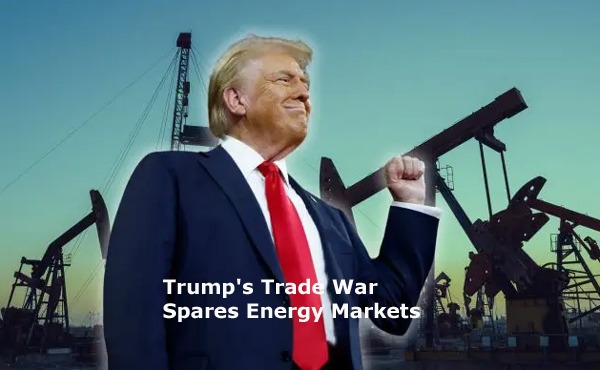Oil and gas got off easy on Trump’s Liberation Day: Bousso

Ron Bousso, Reuters
LONDON
EnergiesNet.com 04 03 2025
President Donald Trump‘s reveal of sweeping import tariffs further darkened the outlook for the global economy and left many questions unanswered. But amid all the policy fog, oil and gas traders can point to a few bright spots.
At an event in the White House Rose Garden, Trump announced tariffs on imports from many major trading partners, including a 20% fee on the European Union, 24% on Japan, 27% on India, 10% on Britain and 34% on China. He also set a baseline 10% tariff on all imports.
The move intensified a trade war and drew condemnations from world leaders.
The obvious conclusion is that this is all highly bearish for energy markets, as the expected retaliation from governments around the world should weigh on global economic prospects, putting more downward pressure on oil and gas prices.
Indeed, financial markets and benchmark crude oil prices were sharply lower on Thursday, with Brent losing around 2.5% to $73 a barrel. However, that is still higher than prices were a month ago, before the ratcheting up of Middle Eastern tensions, U.S. tariffs on Venezuela and threats of secondary tariffs on Russia and Iran.
Energy markets may remain volatile in the short term as traders absorb the tariff sticker shock, but once the dust settles, the oil and gas industry may find that the outlook isn’t so grim.Europe accounted for 48% of U.S. crude exports of 4 million bpd in 2024
SILVER LININGS
First, these announcements provide the industry with some clarity. True, the proposed tariffs are likely to shift around in the coming months as Trump tries to wring concessions out of trading partners. But at least now everyone knows the baseline they’re working with.
And the fact that all U.S. imports of oil, gas and refined products were exempted from the tariff plans should let the industry breathe a partial sigh of relief.
It is good to remember that despite the huge growth in U.S. energy production and exports over the last decade, it continues to import a large amount of oil due to its large domestic refining capacity of 18.4 million barrels per day.
The U.S. imported 6.6 million bpd in 2024, including 4 million bpd from neighbouring Canada and 464,000 bpd from Mexico.
If Trump had slapped onerous tariffs on Canadian crude, refiners may have struggled to source the heavy grade they need. They are already paying up for Canadian crude due to the previously announced measures against Venezuela.
Second, traders can assume that, despite all the changes these lofty and oddly designed tariffs might bring, they probably won’t dislodge the United States from its dominant position in global energy markets.
The United States was the world’s top exporter of liquefied natural gas (LNG) in 2024, ahead of Qatar and Australia, with the majority of U.S. volumes going to the European Union.
Additionally, it exported 4.1 million bpd of crude last year, according to the Energy Information Administration, more than 10 times the total one decade prior. Europe imported 48% of the volumes in 2024, followed by South Korea at 12%, and India and Taiwan at 6% each.
In theory, the concentration of oil and gas in the U.S.’s export basket could be considered a vulnerability. But in reality, governments will likely think twice before hitting U.S. energy imports with tariffs.
Why? Because these countries have very few alternative sources of supply, and higher energy costs would make it very challenging for them to boost their economies to offset the tariff pain.
If anything, countries under fire from Trump’s trade war will seek to purchase more U.S. energy to placate the administration.
Indeed, European Commission President Ursula von der Leyen has in recent months already suggested the EU could increase its purchases of U.S. LNG at the expense of Russian fuel in order to reduce the bloc’s trade deficit with the United States.The U.S. was the world’s top exporter of liquefied natural gas in 2024, shipping 87 million tons
BRAVE NEW WORLD
Finally, following Wednesday’s announcements, the world now knows that Trump isn’t bluffing about this trade war. This may ultimately push more countries to reduce their reliance on the U.S. by making long-needed investments, spurring growth domestically and ultimately increasing demand for oil and gas.
Germany’s rapid U-turn on defence and infrastructure spending and China’s accelerated push to boost domestic consumption and catch up in the artificial intelligence race may just be the beginning.
Of course, any fragmentation of the global economy will likely create manufacturing and trade inefficiencies and increase consumer prices. But this could simply lead to duplications of industries and new transportation routes.
So as governments around the world weigh their responses to Trump’s tariff barrage, energy traders may continue to fret about the potential impact on oil and gas consumption. But, at least for now, it looks like the industry may have made it through “Liberation Day” relatively unscathed.U.S. crude oil imports
Ron Bousso; Editing by Jamie Freed
EnergiesNet.com 04 03 2025













